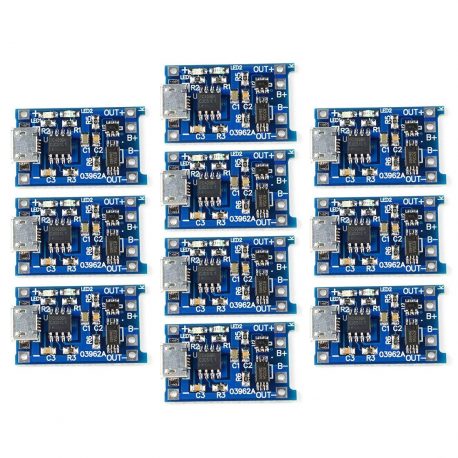

Since a diode is positioned at the positive of the battery, the LM 317 output must be set to about 4.2 + 0.6 = 4.8 V (for a single cell) for compensating the accompanied diode forward voltage drop. The 10 k preset positioned at pin3 of the opamp is used for setting the over charge level, for a 3.7 V li-polymer battery this may be set such that the output of the opamp goes high as soon as the battery is charged to 4.2 V (for a single cell). The section at the extreme right which incorporates an opamp is the over charge cut off stage and makes sure that the battery is never allowed to overcharge, and cuts off the supply to the battery as soon as the over charge threshold is reached. This may be accomplished by adjusting the accompanied 10k pot or a preset. The IC here is basically used for setting up the exact required charging voltage level for the lipo battery.

It will not allow more than 1.5 amps across it's outputs and ensures a safe amp level for the battery. Referring to the shown Lipo battery charger circuit diagram, the entire design could be seen configured around the IC LM317 which is basically a versatile voltage regulator chip and has all the protection features built in. Since here we are interested in designing a lithium polymer (Lipo) battery charger circuit, we'll concentrate more on this and see how a lipo battery may be charged safely yet optimally using components that might be already sitting in your electronic junk box. Having said that, it's always a better and a safe idea to charge such critical devices with a rate that may be lower than the max specified level, a C x 1 could be the taken as the optimum and the safest rate of charging. It means the amp rating of the input could be ignored in most cases since the rating may not exceed the 5 x AH spec of the battery, in most cases. The above specs actually gives us the liberty of using much higher current inputs without worrying about an over current situation for the battery, which is normally the case when lead acid batteries are involved.

However if look at the these specifications in detail we find it to be rather lenient as far as the rates are concerned, to be more precise a Lipo battery can be charged at the rate of 5C and discharged even at much higher rates, here "C" is the AH rating of the battery. Thanks, looking forward for a reply.Ī Lithium polymer battery or simply a lipo battery is an advanced breed of the more popular lithium ion battery, and just like it's older counterpart is specified with stringent charging and discharging parameters.
LIPO BATTERY MONITOR CIRCUIT HOW TO
I just need to know on how to modify the circuit to make it LiPo compatible with constant voltage and constant current or CC and CV rates.

Can you give me any other option pertaining my issue. I am aware that the circuit mentioned in “Bicycle Dynamo Battery Charger Circuit” will not be useful for my purpose. The current generated is intended to be used to recharge 30C 11.1V 2200mAh 3 cell LiPo battery.
LIPO BATTERY MONITOR CIRCUIT GENERATOR
Together with this, I am working on energy generation by attaching a generator to each motor. My concern is not regarding the switching circuit. Once the primary battery gets beyond a preset voltage, secondary battery will power up the robot’s system. I am working on a hexapedal robot with battery switching mechanism. I would like to ask something regarding that article. I came across your work on “Bicycle Dynamo Battery Charger Circuit” in Homemade circuit design blog. Charging a Single Lipo Cell with CC and CV


 0 kommentar(er)
0 kommentar(er)
